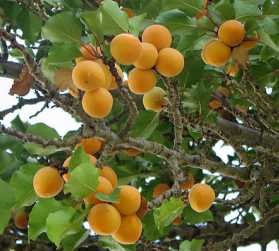How to Grow Apricots – A Guide to Growing Apricots
 Apricots can be more difficult to grow than other tree fruit due to their sensitivity to frost. The further north, the more difficult. Not all varieties thrive in all areas, so advice should be sought when you choose your tree as the most suitable for your location.
Apricots can be more difficult to grow than other tree fruit due to their sensitivity to frost. The further north, the more difficult. Not all varieties thrive in all areas, so advice should be sought when you choose your tree as the most suitable for your location.
Apricots
Plant bare rooted trees in autumn while the soil is still warm and the tree dormant; container grown trees may be planted at any time of year as long as the soil is not frozen or completely sodden. Harvest August–October, depending on the variety.
Growing Apricots
- Apricots need a sunny, sheltered, frost-free location in fertile, free-draining soil if they are are to thrive and produce a good crop of fruit.
- They flower early in the year and the blossom needs protection from frost – in cooler areas you will need to grow them trained against a sunny wall or in the shelter of a greenhouse. Read about fan-training and pruning.
- Always plant your fruit tree so that the grafting union is above the level of the soil.
- Dig a hole large enough to comfortably accommodate the depth and size of the roots, add some well-rotted organic matter/compost, and water in well after planting. Don’t let your new fruit tree dry out, particularly during the first couple of years.
- Remove any vegetation around the base of the tree and mulch well, to help keep in the moisture and discourage weeds growing and competing with the young tree.
- Feed with a slow release fertilizer and then mulch each spring.
- Apricots are self-fertile but in cool weather (or if growing in cooler areas) pollinate the flowers by hand. Try to do this on a cool day, when rain is not forecast. Using a clean, soft paint brush transfer pollen from one bloom to another.
- Thin the fruits once they are around the size of walnuts, leaving one fruit per cluster and spaced approximately 22 cm ( 9 inches) apart.
- Prune in spring or from the end of July to late August. Apricots bear fruit on shoots made the previous summer and on short spurs from the older wood.
Harvesting Apricots
- Harvest late July–August.
- The fruits are ripe when they come away easily from the tree.
- Pick them carefully to avoid bruising the tender fruit.
Pests and Problems with Apricots
- Protect with horticultural fleece in low temperatures and when frost is forecast to prevent damage to buds and blossom.
- Apricots can suffer from dieback, particularly after frost damage – cut out any affected areas.
- Canker can also affect apricots, as well as aphids and spider mites particularly if the tree is cultivated in a greenhouse.
Varieties of Apricot
- The final height of a mature apricot tree grown on St Julien A rootstock will be 3.5–4m (11.5–12 ft), although they can be kept smaller if fan trained or grown as a bush.
- Apricots are also grow on Torrinel, a semi-dwarfing rootstock, which produces smaller tree, around 2–2.5m (6.5–8 ft) and can be grown in a large container.
- Many modern varieties have been specifically developed crop successfully in cooler climates.
Eating
- Apricots will keep for a week or so in the fridge but are most delicious and juicy when eaten fresh from the tree.
- They can be dried or transformed into jam or apricot curd.



